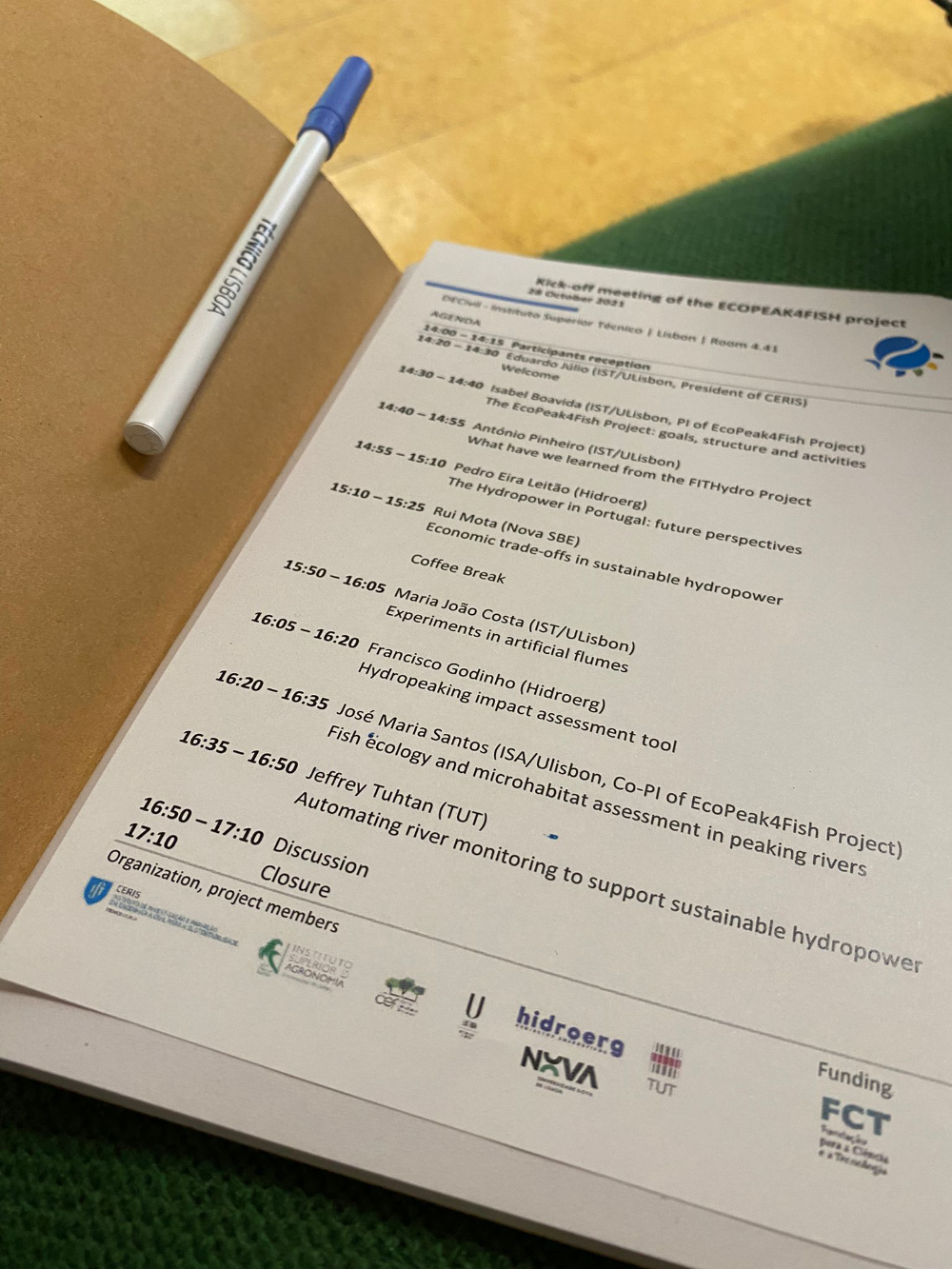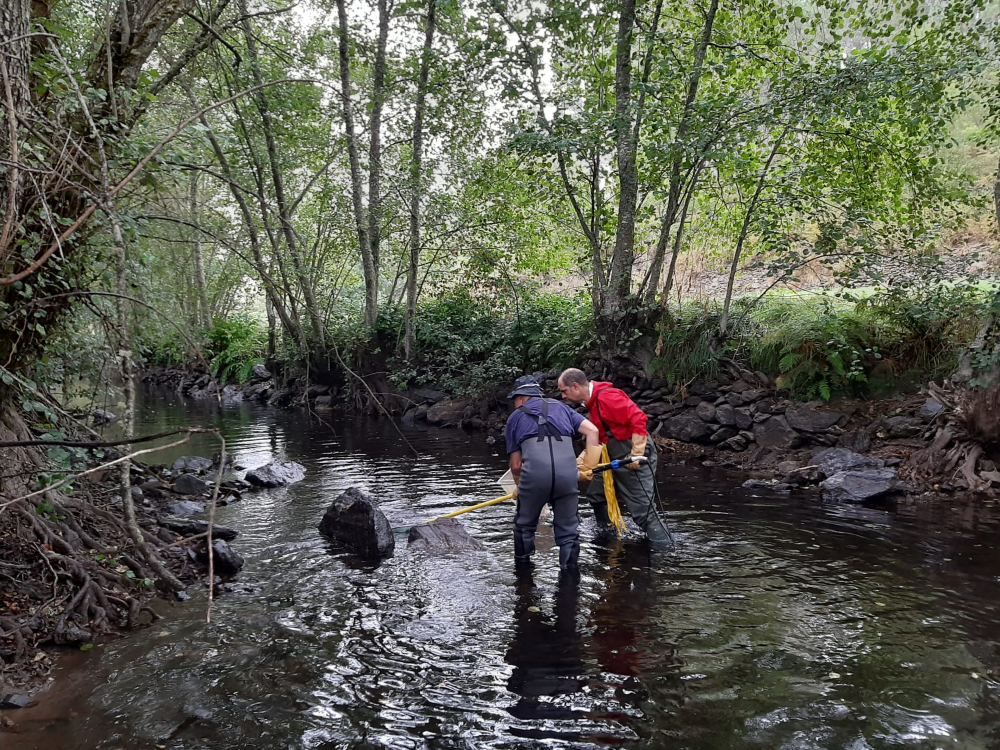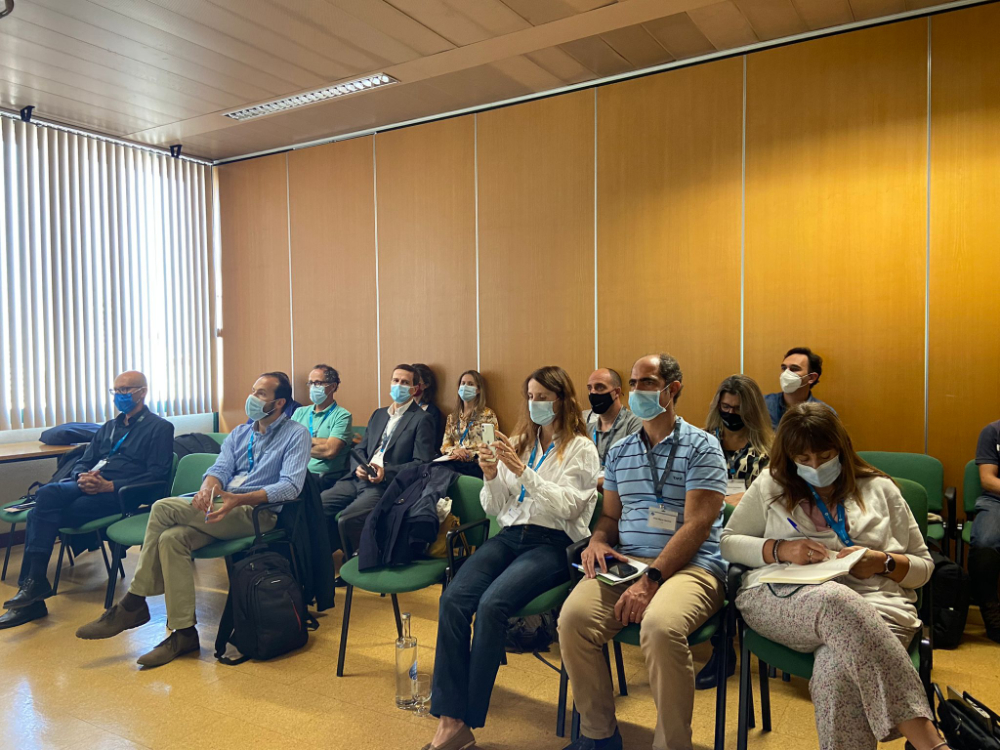
The logo
The concept for the logo of EcoPeak4Fish was based on the ancient Chinese yin-yang philosophy, showing a fish on the left side, and a turbine, representing hydropower, on the right side.



EcoPeak4Fish kickoff
The event took place on the 28th of October 2021 in hybrid format to assure that the project goals, team, structure and activities would target a wider national and international audience that shared mutual interests considering hydropower production and freshwater ecosystem protection.


Flume experiments to evaluate the use of flow-refuges by Iberian cyprinids
Autumn campaign for Task 2 is now completed!

The logo
The concept intends to demonstrate how seemingly opposite forces may actually work together and be interconnected. It is possible to assure the sustainability of freshwater fish communities if hydropower producers are willing to promote the restoration of the downstream habitat and/or to adapt the plant operational scheme according to ecological requirements.
In the turbine side of the logo, the 4 blades with the different colours represent the 4 E's of EcoPeak4Fish: Ecology, Engineering and Economy, acting together for the protection of the freshwater Ecosystem. We are certain that our multidisciplinary team will produce science-based, cost-effective and integrative solutions, such as the implementation of habitat enhancement measures downstream of hydropower plants, and recommendations to adapt the operation scheme to minimize the impacts on fish communities without compromising energy production.
Behind the original concept and the design of the logo is the work of Ricardo Pinheiro.

Fish ecology and microhabitat assessment
The fieldwork for Task 1 is completed! Fish ecology and microhabitat assessment consisted of two sampling campaigns performed on late-spring (fish spawning period) and on late-summer (growing period), respectively. The goals of this task are two-fold: i) to assess fish microhabitat use at reference and hydropeaking-affected rivers (the outputs will feed Task 2), and ii) to calculate the area of suitable habitat in peaking rivers, specifically in the segments downstream Bragado and Covas do Barroso Small Hydropower Plants (the outputs will feed Task 4).
Data are now being screened and analysed. Overall, fish sampling campaigns revealed that fish species composition at the reference sites are dominated by chub (Squalius carolitertii) (45%), straight-mouth nase (Pseudochondrostoma duriense) (30%) and brown trout (Salmo trutta) (21%). The most common species at the hydropeaking sites were by far the straight-mouth nase, representing more than three quarters (76%) of the total fish captured, followed by chub (14%) and, in similar proportion (5%), by brown trout and calandino (Squalius alburnoides). This task will answer the following questions: i) do these species select specific microhabitats in reference and hydropeaking-affected sites (i.e. do they show non‐random microhabitat use)?; ii) do these species show seasonal or ontogenetic (i.e. size‐related) patterns in microhabitat use?; iii) which are the most important variables that drive microhabitat use in reference and hydropeaking-affected river sites?

EcoPeak4Fish kickoff
The event took place on the 28th of October 2021 in hybrid format to assure that the project goals, team, structure and activities would target a wider national and international audience that shared mutual interests considering hydropower production and freshwater ecosystem protection. This event gathered students, scientists, hydropower producers, consultancy companies, environmental NGO's and public entities for the protection and management of the environments that, at the Civil Engineering Department of IST and online, were able to participate actively.
Eduardo Júlio, professor at Instituto Superior Técnico and president of the CERIS Research Unit, has officially opened the event and applauded the project, its integration in the renewable energy sector, and particularly, the certified facilities and innovative technologies that will guarantee the project success. Isabel Boavida, the project leader, presented a general overview of the project and introduced the main research questions that it will address: How do fish react under hydropeaking conditions? Are flow-refuges an effective measure to mitigate impacts and contribute to the self-sustainability of fish populations? How to identify the hydropower operation scheme that maximizes profit and power production and, at the same time, guarantees suitable habitat for fish communities?
These questions are compatible with the future challenges of the renewable energy sector presented by Pedro Leitão, manager of the hydropower company Hidroerg. Rui Mota, researcher at NOVA School of Business and Economics will lead the research to develop a model that will be able to describe a small hydropower plant operating in hydropeaking while including habitat and fish ecological requirements in the model, thus ensuring the ecological requirements downstream of the hydropower plant. This major output will be the basis to review the present regulations regarding environmental flows. António Pinheiro, professor at Instituto Superior Técnico, and Francisco Godinho, freshwater ecologist and consultant at Hidroerg, presented the main outputs of the European H2020 FITHydro Project, and how these are expected to contribute for EcoPeak4Fish.
The ecological component of the project was presented by José Maria Santos, freshwater ecologist and professor at Instituto Superior de Agronomia, who reinforced the importance to quantify fish habitat use in peaking rivers and exposed the methodology that was adopted for this assessment. Maria João Costa, hydrobiologist and researcher at CERIS, focused on the diverse experiments that were conducted in the flume and how these, together with fish microhabitat assessment, will be used to test different types of flow-refuges. The main output, a flow-refuge prototype will be deployed downstream of the Small Hydropower Plants that represent the project test-cases and its use by fish will be monitored. Finally, Jeffrey Tuhtan, Professor and Head of the Environmental Sensing and Intelligence Lab in Taltech, presented the technological aspect of the project. His presentation focused on innovative automated river monitoring technologies to support sustainable hydropower and in their integration in EcoPeak4Fish.
This was a successful event, given by the speakers, the discussion periods after each presentation and at the end of the event, where both audiences posed their questions and comments mostly regarding the future of the project and its envisioned outputs.

Flume experiments to evaluate the use of flow-refuges by Iberian cyprinids
Autumn campaign for Task 2 is now completed! During the first three weeks of November 2021, we carried out experimental trials at the flume located at the Laboratory of Hydraulics (IST) to test two different types of flow-refuge as mitigation measures to hydropeaking for Iberian cyprinids. For each type, we deployed two flow-refuges, upstream and downstream, in one side of the flume. The flow-refuges differed according to the angle of insertion in the flume wall. The rationale behind this idea was to find out whether the approach angle influenced the ability of Iberian cyprinids to use the flow-refuge. Based on our preliminary observations, we are optimistic regarding the use of these overhead and low-velocity hideouts by Iberian cyprinids. Under peak-flow conditions, fish used the upstream and downstream flow-refuges, but depending on the fish position at the start of each experiment, the use frequency differed.
We are now ready for some data analysis, and to think about optimized flow-refuge configurations to be tested in spring 2022. Which angle was the most adequate for fish under peak-flows? Stay tuned for future results!

 The EcoPeak4Fish team wishes you a Merry Christmas and a Wonderful 2022!
The EcoPeak4Fish team wishes you a Merry Christmas and a Wonderful 2022!



